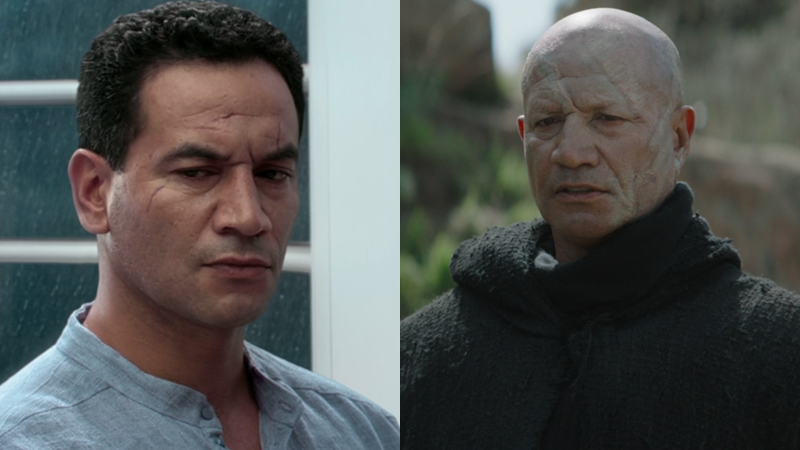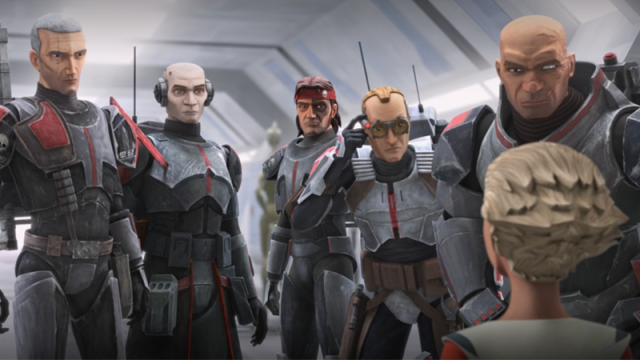This week a new Star Wars animated series on Disney+, The Bad Batch, re-introduced us to the last days of the Clone War and the rise of the sinister Empire. But amid the blaster fights and familiar faces, some fans have shown concern that the show’s major characters have had their skin tones adjusted, pushing them away from their roots.
The Bad Batch stars Dee Bradley Baker, who has been the voice of Star Wars’ Clone Troopers since The Clone Wars began in 2008, as the titular Clone Force 99. First introduced in Clone Wars’ final season last year, Clone Force 99 — made up of soldiers named Hunter, Wrecker, Crosshair, Tech, and former ARC Trooper Echo — is a unique special operatives task group for the Republic Army, rare “defective” members of the original base template for the clones. However, those “abnormalities” manifest in not just altered appearances compared to standard clones — derogatorily referred to in The Bad Batch as “regs” — but in enhanced abilities, like increased strength, marksmanship skills, or hyperintelligence. But with after this week’s bumper-length premiere, some fans have expressed concerns that these differences also are made clear by an altogether different factor: the colour of their skin.
For those unfamiliar, every Clone Trooper — in live-action Star Wars movies and animated projects like The Clone Wars, Star Wars Rebels, and now The Bad Batch — is based on the genetic material of Mandalorian Bounty Hunter Jango Fett. He’s played by Attack of the Clones and The Mandalorian star Temuera Morrison in live-action Star Wars projects, who was born in New Zealand and is of Māori, Scottish, and Irish descent. With his recent return to Star Wars portraying Jango’s son, Boba Fett (in both The Mandalorian and the upcoming limited series The Book of Boba Fett), the actor has discussed how he wants to bring elements of his Māori cultural heritage to his portrayal of the character.

Although Morrison did not voice the animated Clone Troopers (Baker, who is white, adopts a loose, Americanized approximation of Morrison’s portrayal), their appearance in Lucasfilm’s animated projects has been based on his appearance from the get-go. Even as aesthetics have changed — The Clone Wars, in particular, underwent multiple stylistic and graphical improvements over the course of its seven-season run, stretched across 12 years — one thing that has remained relatively unchanged is that Clone Troopers all have a similar darker complexion, reflecting Morrison’s Polynesian background.
This brings us to The Bad Batch. Although some concerns about the characters’ skin colour and facial structures were raised during their debut Clone Wars episodes, fan concern swelled in the run-up to the new animated series as trailers and footage were released. While The Bad Batch is a successor series to Clone Wars, its creatives — including executive producers Jennifer Corbett and Brad Rau (who are also both head writer and supervising director on the series, respectively) — have noted in press that the series has undergone refinements to its predecessor’s technological and aesthetic processes.

However, with those tweaks has come concern that there are visual choices that make the Bad Batch appear significantly different from the clones of Clone Wars. Each member of the squad has, to varying degrees, radically different facial structures compared to standard clones as part of their designs, but also varying tones of complexion. Some characters, like Wrecker and Hunter, trend to a darker skin tone, while characters like Crosshair and Tech — who also have significantly lightened hair colours compared to the black hair of usual clones — are presented as much lighter-skinned. Only Echo, who, as a standard clone still looks primarily like his predecessors in the Clone Wars, has undergone minor structural changes in his face. However, the character has also been largely drained of skin colour, presented not as Caucasian but almost literally white. This was explained in the prior series as a result of capture and torture as a prisoner of war at the hands of Separatist forces, which involved cybernetic implants and imprisonment for several years.

Regardless of variance within the squad itself, the characters stand out particularly in contrast when put alongside the standard clones in the series premiere, “Aftermath.” Although the episode primarily takes place in locations that are brightly lit — like the planet Kaller, and the clone’s “homeworld” in the sanitised laboratories of Kamino — which plays a part in lightening character’s complexions in general, there are still notable differences between how the Bad Batch appear compared to their “reg” counterparts, and the Polynesian man who inspired all of them in the first place.
The issue is not restricted to the titular characters, either. Omega, a new female child introduced in the show (and voiced by New Zealand actress Michelle Ang), is revealed in the episode to also be a “defect” clone from the same batch as the primary characters, but in turn, her skin tone appears significantly lighter in colour than standard clones, and she was given pale blonde hair. Outside of clones, a surprise appearance by young Jedi padawan Caleb Dume (who eventually goes on to be known as Kanan Jarrus, a primary character in the animated series Star Wars Rebels) in the episode’s opening has bothered many as well. Even taking into consideration the bright lighting of the scenes Caleb appears in — a newly released official promotional picture of the character for merchandise gives the child a warmer complexion — the skin tone is still considerably lighter compared to the darker complexion his adult self has in Rebels.

All this has lead to fans concerned about the show’s visual changes — which to them can be read as at best somewhat ignorant, and, at worse, as a racist creative decision — to rally on social media. Utilising the one-page site hoster Carrd.co to share a collection of comparison pictures and anti-racist resources created by Tumblr user CloneHub, fans troubled by the depiction of these characters have united under the hashtag #UnWhiteWashTBB, asking Lucasfilm to at least acknowledge concerns and make efforts to alter The Bad Batch’s design and aesthetic choices as the show progresses.
Although Lucasfilm has yet to make a public statement about the reaction to the show’s, there are signs that feedback has been taken internally. A source familiar with production of The Bad Batch told Gizmodo that in in the run-up to its premiere this week, changes to the lighting tools utilised by the animation team were made to moderate their effects in the premiere episode’s starkly-lit primary settings. Such tweaks will also be made in future episodes of the series.
Whether or not those internal changes will satisfy some fans’ concerns remains to be seen. The Bad Batch discussion comes at a time when Lucasfilm has attempted to grapple with reckonings of racism and wider issues of diversity both within Star Wars fandom and in the Star Wars media being created by the studio. In the summer of 2020, Lucasfilm made a rare public statement supporting sequel trilogy star John Boyega for participating in London-based Black Lives Matter protests.
This followed the actor’s own public expression in several interviews that as a Black lead in Star Wars projects, he felt under-supported in both the arc of his character, Finn, and when it came to racist harassment and backlash he received from fans. The studio had likewise failed to take a stand against racist and sexist abuse Raya and the Last Dragon star Kelly Marie Tran received, leading to her closing her social media accounts after the release of Star Wars: The Last Jedi. The issue was further compounded when Lucasfilm faced criticism and allegations that Tran’s character, Rose Tico, had her role drastically reduced in the final film of the trilogy, The Rise of Skywalker.

However, there are finally signs of attitudes within the company slowly changing when it comes to actively addressing concerns of racism and a lack of diverse voices in leading roles. A swath of recently announced projects are either helmed by or star a more inclusive set of creatives when compared to Star Wars’ past. For example, Taika Waititi’s Star Wars film, Deborah Chow’s Obi-Wan Kenobi limited series, or the aforementioned The Book of Boba Fett, helmed by The Mandalorian’s Robert Rodriguez and starring Morrison alongside Ming-Na Wen (who’s also set to reprise her role as bounty hunter Fennec Shand in The Bad Batch). In addition, earlier this year, Lucasfilm posted an official statement on Twitter to stand by presenter Krystina Arielle, host of the company’s ongoing monthly YouTube series The High Republic Show, after she was targeted with racial and sexist abuse by prominent right-wing conservative commentators.
Positive changes in presenting a more diverse galaxy far, far away also come with acknowledging when the studio errs in its depiction of characters of colour and other diverse backgrounds, however. Time will tell how or if Lucasfilm will plan to act upon these concerns in the future, outside of potential changes to lighting on The Bad Batch and future projects. But discussion like this shows that for all the steps forward Lucasfilm has taken to broaden and expand its perception of Star Wars, both within the fiction and within its fandom, there are still many, many more steps to take.
